

|
Home Updates Hydros Cars Engines Contacts Links Contact On The Wire |
|
Keith Vincent Swift
|
|
"A gentle man and a gentleman" |
To say that Keith Swift had a great influence on the development of my life would be a total understatement. I first met Keith at Kirrawee High School. It was a brand new establishment and was officially opened in 1966. My first year there was the third bunch to go through. That made it 1968 and I was 13 years old, the same age Keith would have been in 1942, right in the middle of the second world war. In later life it became obvious how much this had influenced his life and outlook on things. During my 6 years at Kirrawee High School Keith taught me and many others Technical Drawing, Metalwork and Woodwork. His classes were always peppered with a touch of excitement and wonderment. As the memories come flooding back I can recall vividly the very first Metalworking lesson. Keith was pointing to a sectional drawing of a two-stroke engine and asked if anyone in the class knew the name of the part that holds the connecting rod to the piston. My hand shot into the air. The bewildered look on Keith’s face as he heard the words, "It’s called the gudgeon pin, Mr. Swift" is something I cannot forget. It was revealed many years later that I was the only kid Keith had ever taught that knew the correct answer. From that day on we formed a very reliable friendship which lasted until his untimely demise on the 20th December 2008.
During our formative years we are unknowingly moulded by people we respect, look up to and associate with. There are probably only four people that I can remember that have been "turning points" during those early years of my life. My Dad, my brother Stephen, another kid my age who befriended me when we moved to the city from the country called Steve Kell and a larger than life teacher called Keith Swift. He was more than a teacher, he was a mentor, worldly wise and exuding experience and only too happy to pass on hard earned knowledge to those who bothered to listen. Looking back, he was a "students teacher", the equivalent of a "mans man" in my then, yet to come adulthood.
|
Steve Kell’s father was racing Karts
with 125cc Victa and Hurricane engines. Mermaid outboard engines were yet to
come and dominate the sport for a while before the McCullochs and then the
Italian racing engines took over. Karting was in its infancy but interested us
greatly. Steve was building a mini-bike and it was to be powered by an old 125cc
Victa engine we had removed from a lawn mower that we found dumped in the bush.
So I asked my Dad if I could take the Villiers engine from his "old" mower to
build myself a mini-bike, as he had just bought a new Victa. The answer was yes.
I got started cutting and welding the frame members and dismantling the old
engine.
|
|
|
|
My Dad still recalls the day when I clamped the re-built engine in the bench vice and pull started it into life. He could hear my shouts of glee from the front yard, "It goes, it goes". I was only 14 years old. This was later replaced by a warmed up Victa 125cc. Within 3 years my knowledge and understanding of the two-stroke engine had gone from almost zero to expansion chambers, tachometers, lightened flywheels, port timing modifications, compression ratios and the kid in the picture above was timed at just over 60 miles per hour on what was to become known as 'The Mansell Victa' among my peers at Kirrawee High. All assisted in every way possible by Mr. Swift. During the 'record run' he even lent me his crash helmet, the one he wore when racing full sized hydros. (yes, all that hair actually fitted into the helmet along with my head). Mark with tuned up Victa 125cc. Good for 60mph. |
When I say assisted, that is another understatement. Keith had fostered my interest in things of a mechanical nature right from that first day. In Technical Drawing he taught us how to draw the development of a cone. When he added the casual remark that this method is used to manufacture expansion chambers for high performance two-stroke engines and bell mouths for Amal carburettors, my attention was immediately aroused. He lent me a little book, no jacket but a red hard cover the front of which contained in small print the title 'Tuning for Speed' by P.E. Irving. In no small way this little book helped my mathematics, science and drawing. I was encouraged by Keith to perform calculations on mean piston speeds, and inlet gas velocities etc. Yes, he was a great mentor alright. He knew which buttons to press to get me interested. And for this I will be forever grateful.
Whilst all this was going on, Keith was deeply into full sized hydro racing. The New Zealanders had won the Griffith Cup and Keith and a team of other Australians were going across the Tasman to bring it back. I knew all this because of our friendship. Keith would leave the door to the metal work room unlocked so that I and my good friends Kie and Brian could make parts for our mini-bikes during lunch time and free periods. We were amazed to see one day that some smarty pants had written in big chalk letters 'Mansell Racing Division' on the door. It was also common for us to make parts for Keith’s hydro, powered by a pre-unit 500cc Triumph twin, with an interchangeable 650cc that used the same engine mounts. (So in theory it could be run it two classes at the same meeting).
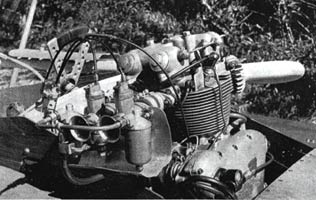 |
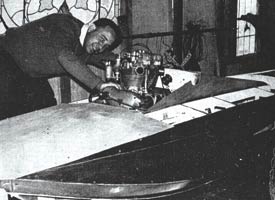 |
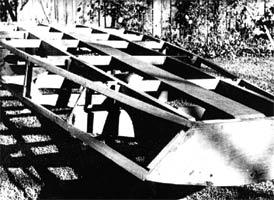 |
| Keith’s Triumph engined hydro "VooDoo".
Note 6 type Amals with SU float bowls. |
Note stepped sponsons on "VooDoo". | "VooDoo" under construction. |
Still being inspired by the writings of Mr. Irving and encouraged by Keith, I started to draw up a rotary disc valve to go into my then pretty quick Victa 125. That is when Keith revealed that his interests in hydros were not limited to the full sized ones. The next day he put on display an outrigger hydro powered by a 5cc Dooling. Apparently it ran around a pole in the centre of a pond attached by a steel wire. So my interest in rotary disc valves grew further. My interest in tethered hydros also grew.
|
Keith was a prolific model builder. He was a pioneer in the outrigger design, years ahead of his time, but put it aside in favour of the traditional shovel nose three pointer designs. His models were sometimes flush sponson mounted but more frequently stepped sponsons were used. This is how he designed and built his full sized hydro. The following article appeared in the New South Wales Hydro Club’s newsletter called 'Hydro Tales'. Keith was instrumental in the setting up of the original Sydney Hydroplane Club all those years ago. He was to go on and become the Patron of that club. His involvement with the full sized hydro’s was vast and he was the official referee at the World Record run by Ken Warby on the 8-10-1978 on the Blowering Dam NSW Australia. The boat was called 'Spirit of Australia' and the new record speed is 317.6 mph and still stands to this day. The boat is now on display at the Sydney Maritime Museum. (When I first saw this boat I was amazed at how small it is). |
|
Keith’s first tethered hydro. FROG 500 powered sitting on the Ashfield model boat pond. Next picture shows it after winning with a speed of 30 miles per hour. This boat was called 'Alter Ego' after the full sized boat to Paul Sawyers design. Inscription reads, 'Alter Ego' Built by K. Swift. Frog 500 powered. Speed 30 mph.
|
|
|
Another of Keith’s tethered hydros was based on the famous 'Miss Thriftway'. I have replaced the original McCoy Babe Bee with a 2.5cc diesel Taipan converted to glow.
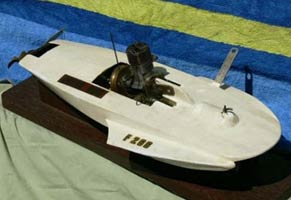 |
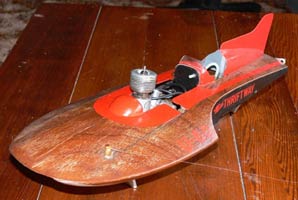 |
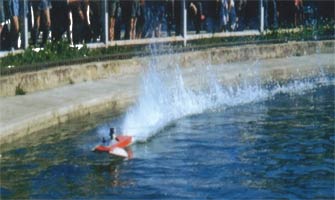 |
| The restored ‘Alter Ego’. |
Close up of ‘Miss Thriftway’. The engine cover wouldn’t fit after the engine went in. |
Ashfield lake in the 50s |
Though not one of Keith’s boats, the photo (above right) is indicative of what they were doing at Ashfield in the 1950’s. Note the third bridle wire from the cylinder head to steady the boat in the vertical plane. (There is a possibility that the boat was built by Ron Cowan).
During a technical drawing class Keith drew on the black board a doubly inclined plane. (Inclined in both the x and the y axis). He explained the importance of this piece of plane geometry by holding up one of his model hydros. Naturally he captured the attention of the whole class at that point. He went on to explain that the true dihedral of that part of the sponson touching the water was critical to the boats performance. To achieve what the designer wanted it had to be doubly inclined. Then he went on to explain how we could calculate this angle by implementing an auxiliary plane and we could also achieve the same end by another technique called rebatment of one plane to another. We had already grasped the importance of true length diagrams. In metal work he would casually produce a pair of inlet valves and mention that they were out of his racing Triumph. "Would anyone like to volunteer to polish them in the lathe for me, I’ve run out of time today as I have all these assignments to mark". No lack of volunteers or enthusiasm in that class.
Even well into retirement Keith was still teaching and passing on his knowledge. I remember my son Andrew asked him how to make a model hydro and Keith said, "Can I have a bit of time to do some sketches?" A couple of days later a letter arrived with the following instructions.
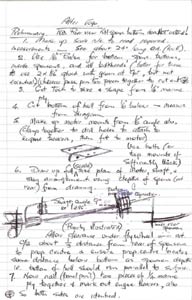 |
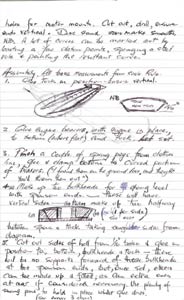 |
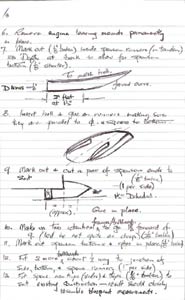 |
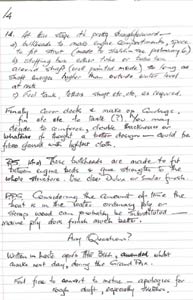 |
Keith made beautiful propeller shafts. There was a time when tiny universal joints were used to alter the angle of the propeller shaft to make it parallel with the line of travel of the boat. This technique has now fallen by the wayside, but was very popular. See pictures of some of Keith’s shafts and universal joints and skegs etc.
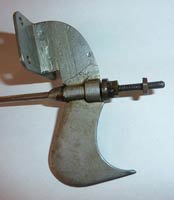 |
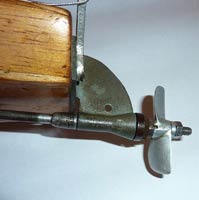 |
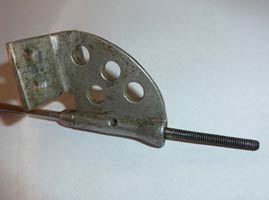 |
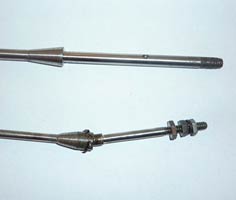 |
|
Very early skeg. |
Stern view of things. The thrust bearing has uncaged ball bearings. |
Old and the new. Tiny universal joint. | |
|
Keith made his own propellers until the proliferation of Octura, Prather, Graupner, Prop Shop et all. Some of these were cast in aluminium and others were fabricated from brass and silver soldered together. Here are a few he made. |
|
Keith had nick names for the kids that stuck like chewing gum to a shoe. One kid called 'Wort' because he looked like one, simply gave up arguing and accepted the name. Other kids were called 'Big Ears' and 'Jumbo'. Years later I bumped into 'Jumbo' and was so embarrassed because I couldn’t remember his actual real name, I only ever knew him as 'Jumbo'. Other things like 'Araldite' for example was always referred to as arrow-dite. Hydraulic cylinders were called hydrochloric cylinders and plastic bags were spastic bags. This wasn’t because Keith didn’t know any better, he certainly did, it was just to add a bit of interest to the job at hand. At one time we referred to Fidel Castro as Fidel "Castrol". Such happiness and fun. We called it mirth!
|
|
FROG 500, with stepped sponsons. Not sure but probably Keith’s second tethered racing hydro. Based on the famous ground breaking design of Ted Jones and built by Anchor Jenson the real sized boat turned the boat racing world into a totally new way of thinking. Tethering points by today's criteria might argue that this is wrong. It worked fine when we ran the boat. This engine started very easily and went up to speed very well, but with a lot of years of tethered racing cars under my belt, I felt that an on-board battery could have helped the performance a bit. Anyway we don’t want to damage the goods by expecting it to do the speeds it once did. This is virtually an antique and thus should be treated with the respect it deserves. |
He was a very keen aeroplane watcher. During the War years he could spot a Hurricane, Mosquito, Wirraway, Canberra bomber, Lancaster or Spitfire at a glance or even by the sound of its engines. He loved the movie 'Dam Busters' and its theme tune was played at his funeral. Very fitting because of his love of aeroplanes and his respect for men like Barnes-Wallis, the inventor, and the men who flew the mission, some of whom never came home. The war years made Keith a very resourceful person. Nothing went to waste. Isn’t it funny how these traits get passed on so easily? Not that he became a hoarder of junk, quite the opposite actually, but if he could see the potential of something being used in or on a model in the future then instead of throwing it away he would keep it and use it later. A pioneer of recycling I suppose. Keith had a Vee 12 Rolls Royce Merlin in his back yard from a Mosquito bomber. As history unfolded and the 50 year secrecy act had expired, it became known that this same engine and the plane it was from, (Keith had all the log books and documentation), was used in the 618 squadron testing the "High-Ball Bouncing Bomb". 617, the famous dam busting squadron was first to use a bouncing bomb but 618 were secretly testing something else. A fully spherical bouncing bomb to be used in open water against battleships etc. The project was abandoned because the bomb sometimes bounced so fiercely off the ocean that it hit the tail of the plane which dropped it and caused it to nose dive into the water.
Keith would often mention things in class that he had experienced first-hand during the war years. Midget subs, Japanese expertise at building fighter planes, German ME109’s, Stukka dive bombers and how the A.V. Roe company had developed a machine which was theoretically superior to the American B17, called a Lancaster, and all because the men in its design office knew what they were doing. The students in Keith’s classes all wanted to become design engineers and work for Brabham or B.R.M. or BHP or QANTAS or Ducati or design new trains powered by better steam turbines than what we had at the time. That’s how inspiring he was. He was also a very practical engineer. I had made a bracket to support the two exhaust pipes from the Triumph engine to the hull of the hydro and had put some lightening holes in but they were a bit out of alignment. I explained that my marking off must have been wrong but he replied with, "It doesn’t matter, you have done a fine job". And in hindsight it really didn’t matter at all, the holes were only running in air.
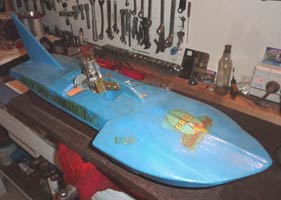 |
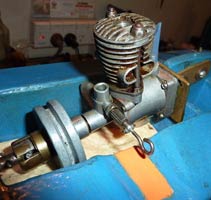 |
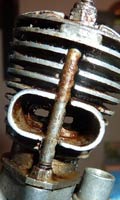 |
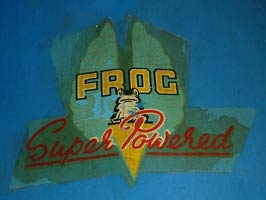 |
| Note the use of the correct racing number U-27 which is etched in history as the boat that turned boat racing on its head. | Showing drive coupling to prop shaft from flywheel. Yes we can see right through this engine. Twin exhaust ports and only two cylinder head studs. | FROG sticker still intact after all these years. | |
In the technical drawing room we had small drawing boards with tee squares. We had to supply our own set squares and instruments. Keith’s kit of drawing equipment consisted of a chalk sharpener known as 'The Swift Gentleman’s Chalk Sharpener' by all, a 60-30 set square and a 45 set square about 12 inches high made out of ply-wood and what seemed to us, a giant set of compasses that could hold a full piece of chalk in the inscribing end and not too sharp that it could damage the black board with the pointy end about 24 inches long. On top of the black board was a track that a vertical straight edge was suspended from and from which all horizontals and squares could be projected. He would draw exactly what we were drawing on the black board and explain things as we progressed. One day we did a fancy piece of perspective drawing and he said, "Don’t ask me to explain how this works, all I know is that it does." Immediately we were all asking how it worked. He replied with, "I asked you not to ask me that". At this time in history, Australian TV was broadcasting a show called 'Get Smart' starring Don Adams as Maxwell Smart as an undercover spy and it was such a funny comedy that everyone was watching it every night. One of Max’s favourite sayings was "I asked you not to ask me that". We were laughing for days. Still laughing as I write this.
|
|
|
|
‘Black Betty’. Swift built hull boat fitted out by Andrew and Mark Mansell. Highly modified FROG 500 power. I made the prop, skeg, shaft, flywheel, con-rod, head and cylinder and piston. |
Another tethered hydro built by Keith that has never hit the water. OPS 7.5cc with pipe. 3 blade prop was out of line with Keith’s usual thinking. Note the increased use of proprietary parts like the fuel tank, expansion chamber and drive coupling. |
A good mate of mine called Kie had a Suzuki 120cc motorcycle which he rode to school. He wanted it to go like his older brother’s 750cc Norton Commando. So we expeditiously set about putting the cylinder head in the shaping machine and removed about 4mm thus increasing the compression ratio to about 19:1. When Swifty learnt of this he made the now famous and almost folk-law remark that, "It will have compression unbeknown to mankind". Kie went on to build a six cylinder Victa utilising six 125cc engines mounted in line with crankshafts joined by special couplings. Keith’s inspiring ways put no obstacles in our way, we could do anything, and we were learning at every turn.
He had a waddy stick under his desk that he used on students that didn’t pay attention or were late or rude in class. If you played up you were called to the front of the class and asked to bend over and WACK on the bum. So humiliating. I thought I was for it one day but managed to escape the embarrassment. It so happened that during a drawing class Mr. Swift was called away for a while and asked us to finish a sectional drawing of a single cylinder air compressor. Back in those days we had the "bodgies" and the "surfies". A kid in the class called Kentwell started badgering me and calling me a bodgie because I was interested in bikes. I asked him to sit down and get on with his drawing. He persisted and called me more names to which I responded by explaining that I too liked a bit of surfing as much as the next bloke and that if he didn’t stop calling me names and interrupting my efforts to finish my drawing then I would hit him in the face. He persisted. So I hit him in the face and he laid on the floor unconscious with blood everywhere. We had a girl in the class who went to his aid while I went back to finishing my drawing. According to my latest information Wendy is now a doctor with the flying doctor service and doing a great job. This all happened in the morning. The ambulance was called and Kentwell was carted off. At lunch time I knocked on the staff-room door and asked to see Mr.Swift. I asked him what punishment I would receive for hitting a Prefect during class. Can’t remember what he said but I know Kentwell and I became very good friends afterwards.
|
|
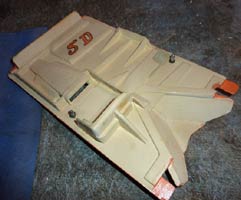 |
|
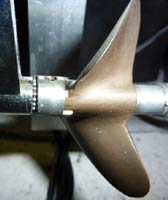 |
|
‘Tallaganda Representative’ in memory of the Braidwood district. This boat is the Picco 15cc water cooled RC outrigger. The last model Keith ever made and has never been in the water. |
As Keith did everything very thoroughly, it is no surprise that the front engine cover is strengthened by reinforcing gussets strategically placed to add strength but not too much weight. Water deflector directly behind air scoop. '5D' is a special pass-word to the ADFA. It seems he put it there for me to find. |
For Keith’s RC Outrigger with the 15cc Picco, he was intending to use twin opposite handed screws. These are they. Later changed back to the tried and proven single screw. |
All of Keith's boats had uncaged thrust ball bearings. Water lubricated. |
So I graduated from Kirrawee High School and started full time employment. Enrolled with Sydney Technical College in Mechanical Engineering, got married, bought a house and started racing Karts. Keith and I were still keeping in touch and it would be quite common for the phone to ring and he would simply say, "Channel 9 now". Meaning Channel 9 on TV had something of mutual interest. I watched Keith and Beverly’s daughters growing up as we all accumulated years. It’s no secret that my first involvement with the Sydney Society of Model Engineers was because my son Andrew was interested in model boats. So we started building tethered hydros, some of which the readers may have already seen. But my interest in tethered cars was overwhelming and that’s how I got into that.
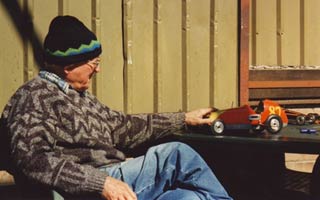 |
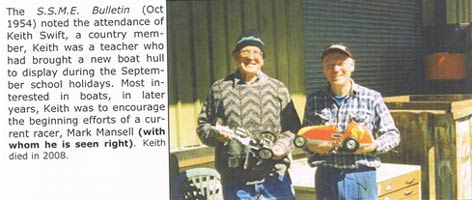 |
I invited Keith out to the Turrella track one day and he said it brought back so many memories for him. One of these days I will be running his and my boats around a centre pole attached by a steel wire. This is the hard part to write now. Keith rang me at work one day and said that if he died, he wanted his model boats to be given to me if that was OK. A few weeks went by and his health was deteriorating. Beverly asked if I could visit Keith in hospital one day. When I saw him he was very ill, so bad that it was hard to recognise the original man he was but still maintained his dignity. Upon leaving we shook hands and he said, "So mote it be". Readers who have heard these words will recognise the significance immediately. I have heard these words many times at the conclusion of special meetings. This was Keith’s way of saying good-bye, it was time to meet the great architect of the universe. As I drove home that afternoon, tears were rolling down my face as I knew I would never see him alive again.
His funeral was on Christmas eve 2008.
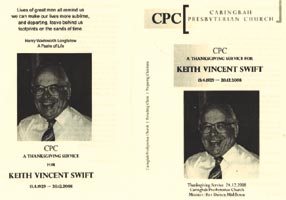 |
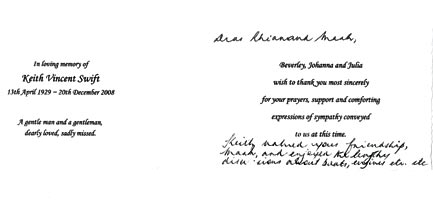 |
Restoration of Voodoo
|
Being the current custodian of the boat, Mark decided that it should have a motor fitted and be back on the water. Keith told me that this thing was under-powered with a 5cc engine so an OPS 60 seems an appropriate replacement. Major works first though, had to cut the existing engine mounts out for the new OPS ones to fit. Keith had riveted the screws over the ends of the nuts before gluing the hull together, making them totally captive. |
|
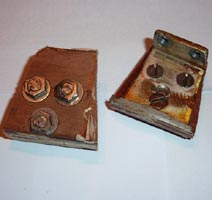 |
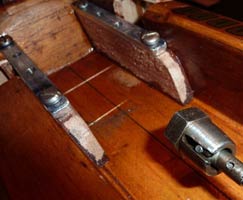 |
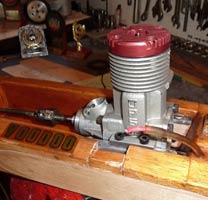 |
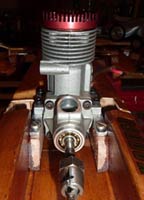 |
| Original engine mounts | New engine bearers glued in. | Engine in, alignment looks good. | It is a VERY tight fit. |
I was determined to rectify the vandalism imposed by cutting out the old engine mounts. The engine alignment is good. The new flywheel is good. Just waiting on the venturi and all is well. Having fixed the hull, how are we going to ‘hide’ the patchwork??? Stain before varnishing maybe?? Try to keep it looking old? There is no way we can hide the modifications effectively, but isn’t that what progress and history are all about, this was Keith’s boat and he was still developing it. Besides, there is still a lot of work to do on the sponsons. Keith told me that as well as under-powered, the sponsons had to be made a lot longer. Let’s see if a 10cc engine and lengthened sponsons can achieve what he was after.
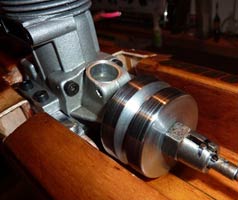 |
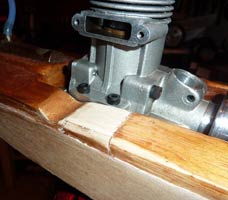 |
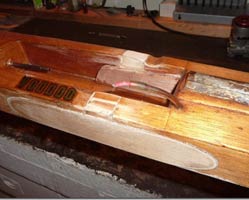 |
| Flywheel finished and in trial assembly. | Dip in deck for original needle valve | Still a lot of work before it hits the water. |
The dip in the deck was to clear the fuel needle when the 5cc engine was installed. I think it should stay there, just to remind us of the history of this hull. Waiting for the glue to dry. Which shouldn’t take long in this heat (32C with a thunderstorm coming). Then the varnish. Still the sponson modifications to be done. The repairs seem to be coming along in an acceptable manner. Let’s face it, if it does an honest 95kmph we will all be happy.
As I have already expressed the opinion that Keith was well ahead of his time in designing and building this hull, albeit underpowered in its original form, let us see the true potential with the design modifications recommended by him, but interpreted by me, the student. His hitherto instructions have usually born fruit. Now let us see.
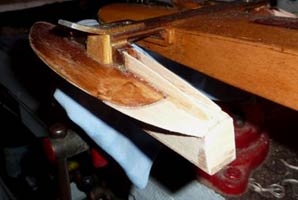 |
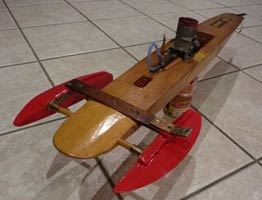 |
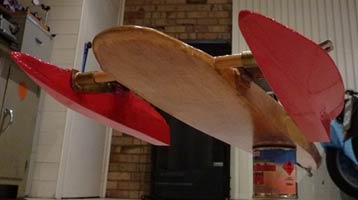 |
|
|
Sponsons basically the same but extended and with sharp exit points from the ends. Looks a bit more in proportion now. |
A set of bridles and a silencer, and the late Keith Swift's 'Voodoo' is set to run again. |
||
©copyrightOTW/MarkMansell2012